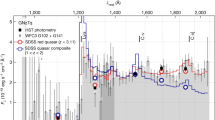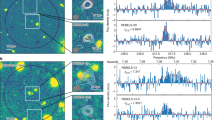Abstract
GALAXIES are believed to have formed a large proportion of their stars in giant bursts of star formation early in their lives, but when and how this took place are still very uncertain. The presence1–6 of large amounts of dust in quasars and radio galaxies at redshifts z > 4 shows that some synthesis of heavy elements had already occurred at this time. This implies that molecular gas—the building material of stars—should also be present, as it is in galaxies at lower redshifts (z ≈ 2.5, refs 7–10). Here we report the detection of emission from dust and carbon monoxide in the radio-quiet quasar BR1202 – 0725, at redshift z = 4.69. Maps of these emissions reveal two objects, separated by a few arc seconds, which could indicate either the presence of a companion to the quasar or gravitational lensing of the quasar itself. Regardless of the precise interpretation of the maps, the detection of carbon monoxide confirms the presence of a large mass of molecular gas in one of the most distant galaxies known, and shows that conditions conducive to huge bursts of star formation existed in the very early Universe.
This is a preview of subscription content, access via your institution
Access options
Subscribe to this journal
Receive 51 print issues and online access
$199.00 per year
only $3.90 per issue
Buy this article
- Purchase on Springer Link
- Instant access to full article PDF
Prices may be subject to local taxes which are calculated during checkout
Similar content being viewed by others
References
McMahon, R. G., Omont, A., Bergeron, J., Kreysa, E. & Haslam, C. G. T. Mon. Not. R. astr. Soc. 267, L9–L12 (1994).
Isaak, K. G., McMahon, R. G., Hills, R. E. & Withington, S. Mon. Not. R. astr. Soc. 269, L28–L32 (1994).
Dunlop, J. S., Hughes, D. H., Rawlings, S., Eales, S. & Ward, M. Nature 370, 347–349 (1994).
Chini, R. & Krügel, E. Astr. Astrophys. 288, L33–L36 (1994).
Ivison, R. J. Mon. Not. R. astr. Soc. 275, L33–L36 (1995).
Omont, A. et al. Astr. Astrophys. (in the press).
Solomon, P. M., Downes, D., Radford, S. J. E. & Barret, J. W. Astrophys. J. (in the press).
Brown, R. L. & Van den Bout, P. A. Astrophys. J. 397, L19–L22 (1992).
Solomon, P. M., Downes, D. & Radford, S. J. E. Astrophys. J. 398, L29–L32 (1992).
Barvainis, R., Tacconi, L., Antonucci, R., Alloin, D. & Coleman, P. Nature 371, 586–588 (1994).
Petitjean, P., Pécontal, E., Valls-Gabaud, D. & Charlot, S. Nature 380, 411–413 (1996).
Djorgovski, S. G. in Science with VLT (eds Walsh, J. R. & Danziger, I. J.) 351 (ESO, Springer, Berlin, 1995).
Fontana, A., Cristiani, S., D'Odorico, S., Giallongo, E. & Savaglio, S. Mon. Not. R. astr. Soc. (in the press).
Hu, E. M., McMahon, R. G. & Egami, E. Astrophys. J. 459, L53–L55 (1996).
Downes, D., Solomon, P. M. & Radford, S. J. E. Astrophys. J. 414, L13–L16 (1993).
Barvainis, R. in Cold Gas at High Redshift (eds Bremer, M., Rottgering, H., van der Werf, P. & Carilli, C.) (Kluwer, Dordrecht, in the press).
Barvainis, R., Antonucci, R., Hurt, T., Coleman, P. & Reuter, H.-P. Astrophys. J. 451, L9–L12 (1995).
Haehnelt, M. J. & Rees, M. J. Mon. Not. R. astr. Soc. 263, 168–178 (1993).
Wampler, E. J. et al. Astr. Astrophys. (in the press).
Magain, P. et al. Nature 334, 325–327 (1988).
Broadhurst, T. & Lehar, L. Astrophys. J. 450, L41–L44 (1995).
Eisenhardt, P. R. et al. Astrophys. J. 461, 72–83 (1996).
Downes, D., Solomon, P. M. & Radford, S. J. E. Astrophys. J. 453, L65–L68 (1995).
Scoville, N. Z. et al. in Cold Gas at High Redshift (eds Bremer, M., Rottgering, H., van der Werf, P. & Carilli, C.) (Kluwer, Dordrecht, in the press).
Storrie-Lombardi, L. J., McMahon, R. G., Irwin, M. J. & Hazard, C. Astrophys. J. (in the press).
Lu, L. Sargent, W. L. W., Womble, D. S. & Barlow, T. A. Astrophys. J. 457, L1–L4 (1996).
Elstou, R., Bechtold, J., Hill, G. J. & Jian, G. Astrophys. J. 456, L13–L16 (1996).
Djorgovski, S. G. et al. Mon. Not. R. astr. Soc. 257, 240–244 (1992).
Franceschini, A. & Gratton, R. Mon. Not. R. astr. Soc. (submitted).
Downes, D. et al. Astrophys. J. 398, L25–L27 (1992).
Author information
Authors and Affiliations
Rights and permissions
About this article
Cite this article
Omont, A., Petitjean, P., Guilloteau, S. et al. Molecular gas and dust around a radio-quiet quasar at redshift 4.69. Nature 382, 428–431 (1996). https://doi.org/10.1038/382428a0
Received:
Accepted:
Issue Date:
DOI: https://doi.org/10.1038/382428a0
This article is cited by
-
Rapidly star-forming galaxies adjacent to quasars at redshifts exceeding 6
Nature (2017)
-
An early stellar nursery
Nature (2003)
-
The formation of cluster elliptical galaxies as revealed by extensive star formation
Nature (2003)
-
Molecular gas in the host galaxy of a quasar at redshift z = 6.42
Nature (2003)
Comments
By submitting a comment you agree to abide by our Terms and Community Guidelines. If you find something abusive or that does not comply with our terms or guidelines please flag it as inappropriate.



